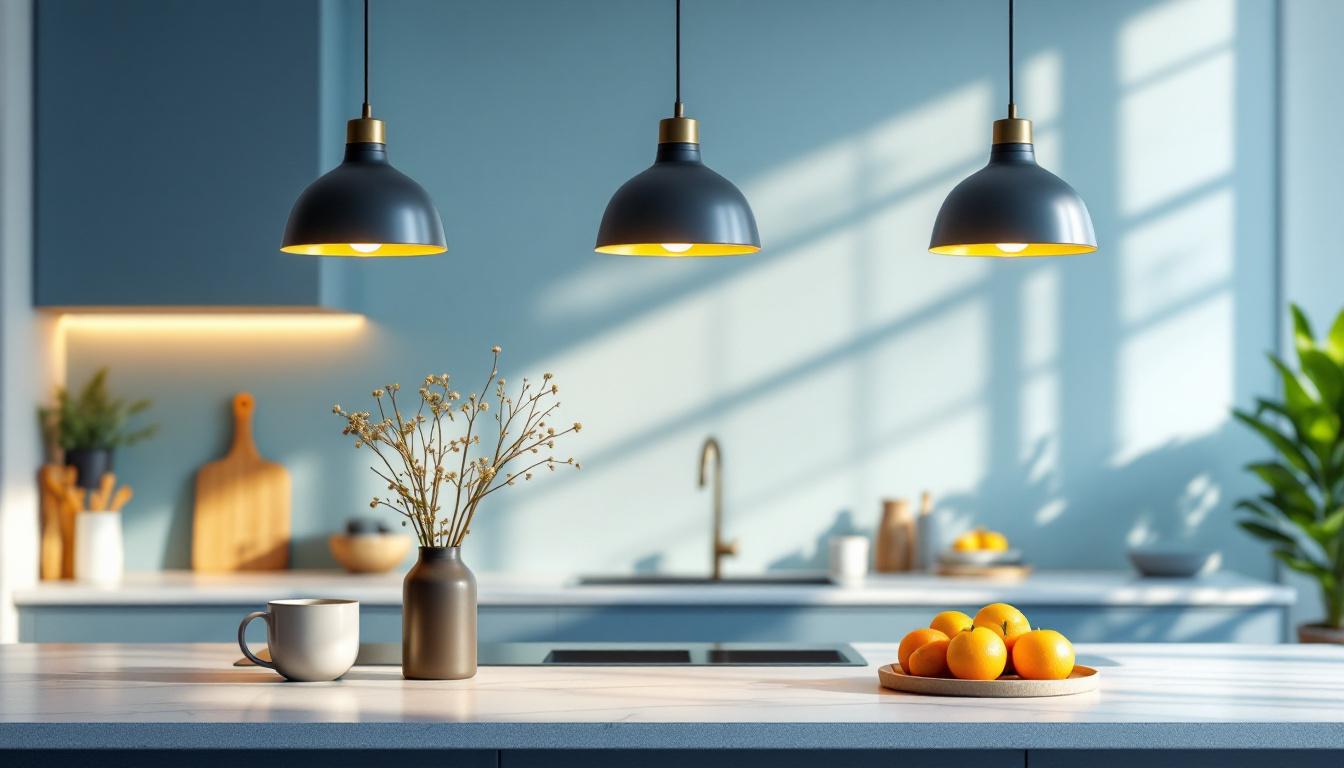
Lighting plays a crucial role in the functionality and aesthetic appeal of a kitchen, particularly when it comes to kitchen islands. As a lighting contractor, understanding the nuances of kitchen island lamps is essential for delivering exceptional results to clients. This handbook is designed to provide insights into choosing, installing, and optimizing kitchen island lighting, ensuring that every project shines brilliantly.
The kitchen island often serves as the heart of the home, where family and friends gather for meals, conversations, and activities. Therefore, the lighting chosen for this space must not only be functional but also enhance the overall ambiance. Proper lighting can elevate the kitchen’s design, making it more inviting and practical. A well-lit kitchen island can create a welcoming atmosphere, encouraging social interaction and making it the perfect spot for hosting gatherings or casual family dinners. The right lighting can also highlight the island’s design features, such as unique countertops or decorative elements, adding to the overall aesthetic appeal of the kitchen.
In addition to aesthetics, kitchen island lighting must meet specific functional requirements. The right illumination can improve visibility for tasks such as food preparation, cooking, and cleaning. It is crucial for lighting contractors to recognize the balance between form and function when selecting fixtures for kitchen islands. Beyond just brightness, the color temperature of the light can influence the mood of the space; warmer tones can create a cozy environment, while cooler tones may enhance focus and productivity. Therefore, understanding the intended use of the kitchen island can guide the selection of the most suitable lighting options.
When it comes to kitchen island lamps, there are several types to consider. Each type has its unique characteristics and advantages, making it essential for lighting contractors to understand the options available. The choice of lighting can also reflect personal style, from modern minimalism to rustic charm, allowing homeowners to express their individuality through their kitchen design.
One of the most critical aspects of selecting kitchen island lamps is ensuring that they are the right size and scale for the space. Oversized fixtures can overpower a small island, while too-small fixtures can look insignificant in a larger kitchen. A general rule of thumb is to choose a pendant light that is approximately one-third the width of the island. This proportionality helps maintain a balanced look, ensuring that the lighting enhances rather than detracts from the kitchen’s design.
Additionally, the height at which the fixtures are hung is equally important. Pendant lights should typically be hung 30 to 36 inches above the countertop to provide adequate illumination without obstructing views. For chandeliers, a height of 28 to 34 inches above the island is recommended, depending on the ceiling height. It’s also worth considering adjustable fixtures that allow for flexibility in height, accommodating different activities and preferences. This adaptability can be particularly beneficial in multi-functional spaces where the kitchen island serves various purposes throughout the day.
Effective lighting techniques can significantly enhance the functionality and aesthetic appeal of kitchen islands. Lighting contractors should consider various strategies to create a well-lit and inviting space.
Layered lighting involves using multiple light sources to create depth and dimension in the kitchen. This technique combines ambient, task, and accent lighting to achieve a balanced and versatile lighting scheme. For kitchen islands, pendant lights can serve as task lighting, while recessed lights provide ambient illumination.
Incorporating dimmers can further enhance the layered lighting approach. Dimmers allow homeowners to adjust the brightness based on the time of day or activity, creating a more adaptable and comfortable environment.
The color temperature of kitchen island lamps can significantly impact the overall mood of the space. Color temperature is measured in Kelvin (K), with lower numbers indicating warmer light and higher numbers representing cooler light. For kitchen islands, a color temperature between 2700K and 3000K is often recommended, as it creates a warm and inviting atmosphere.
However, some homeowners may prefer cooler light for a more modern and energetic feel. In such cases, lights with a color temperature of 3500K to 4100K can be used. Lighting contractors should discuss these options with clients to determine their preferences and the desired ambiance.
Proper installation is crucial for ensuring the functionality and safety of kitchen island lighting. Lighting contractors must adhere to best practices to deliver high-quality results.
Before installation, it is essential to assess the electrical requirements for the chosen fixtures. This includes checking the wattage and ensuring that the existing wiring can support the new lights. If additional circuits are needed, it is advisable to consult with a licensed electrician to ensure compliance with local codes.
Furthermore, when installing pendant lights, it is essential to secure the mounting hardware properly. This ensures that the fixtures are stable and safe, preventing any potential hazards.
The positioning of kitchen island lamps is critical for achieving optimal lighting. For pendant lights, it is essential to ensure that they are evenly spaced over the island. A common approach is to hang three pendants over a standard-sized island, spaced evenly apart.
For chandeliers, positioning should consider the overall layout of the kitchen. The fixture should be centered over the island and aligned with other elements in the space, such as cabinetry and appliances, to create a cohesive look.
Once the kitchen island lamps are installed, ongoing maintenance is essential to ensure they continue to function optimally. Lighting contractors should educate clients on proper care and maintenance practices.
Regular cleaning of kitchen island lamps is vital for maintaining their appearance and performance. Dust and grease can accumulate on fixtures, diminishing their brightness and overall aesthetic. It is advisable to use a soft, damp cloth to wipe down the surfaces of the fixtures regularly.
For more intricate fixtures, such as chandeliers, it may be necessary to use specialized cleaning solutions or tools to ensure that all components are properly cleaned without causing damage.
Another important aspect of maintenance is bulb replacement. Lighting contractors should inform clients about the types of bulbs used in their fixtures, including their lifespan and energy efficiency. LED bulbs are often recommended due to their longevity and lower energy consumption.
When replacing bulbs, it is essential to follow the manufacturer’s guidelines regarding wattage and type. This ensures that the fixtures operate safely and efficiently, providing the desired level of illumination.
Staying updated on the latest trends in kitchen island lighting can help lighting contractors provide clients with contemporary and stylish options. Understanding these trends can also inspire creativity in design and implementation.
One of the emerging trends in kitchen island lighting is the use of mixed materials. Combining different materials, such as metal, glass, and wood, can create a unique and eye-catching fixture. This trend allows for greater customization and can help clients achieve a personalized look in their kitchens.
For example, a pendant light featuring a metal frame with a glass shade can add a modern touch while still providing warmth and character to the space. Lighting contractors should explore various combinations to find the perfect fit for their clients’ designs.
As technology continues to evolve, smart lighting solutions are becoming increasingly popular in kitchen design. Smart bulbs and fixtures allow homeowners to control their lighting remotely, adjust brightness, and even change color temperatures through mobile apps or voice commands.
Incorporating smart lighting into kitchen island designs can enhance convenience and energy efficiency. Lighting contractors should familiarize themselves with available smart lighting products and their installation processes to offer clients the latest innovations in lighting technology.
Kitchen island lamps are more than just functional fixtures; they are essential elements that contribute to the overall design and ambiance of the kitchen. For lighting contractors, understanding the various types of lamps, installation best practices, and maintenance techniques is vital for delivering exceptional results.
By staying informed about trends and innovations in kitchen island lighting, contractors can provide clients with stylish and efficient solutions that enhance their culinary spaces. Ultimately, the right kitchen island lighting can transform a kitchen from a mere cooking area into a vibrant and inviting gathering place.
Ready to elevate your lighting projects with the finest kitchen island lamps? At LumenWholesale, we provide lighting contractors like you with the highest quality, spec-grade lighting products at prices that can’t be beaten. Say goodbye to the middleman and hello to our extensive selection that meets rigorous industry standards. With free shipping on bulk orders, you can trust that you’re getting premium lighting at the best value — no hidden fees, no compromises. Enhance your culinary space designs and give your clients the vibrant, inviting gathering places they dream of. Wholesale Lighting at the Best Value is just a click away. Experience the LumenWholesale difference today!

Discover expert tips and best practices for installing fluorescent light fixtures in suspended ceilings, tailored specifically for lighting contractors.

Discover the answers to lighting contractors’ most common questions about solar outdoor lanterns.

Discover how solar pathway lights are revolutionizing the landscape for lighting contractors.
Discover the essential factors lighting contractors must consider when selecting string work lights.